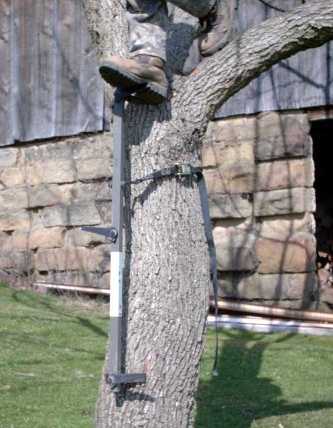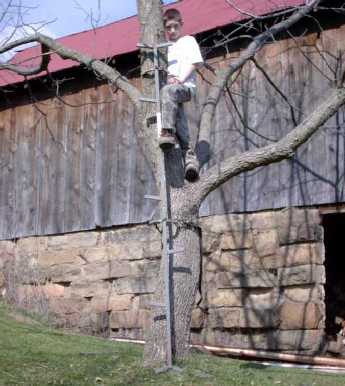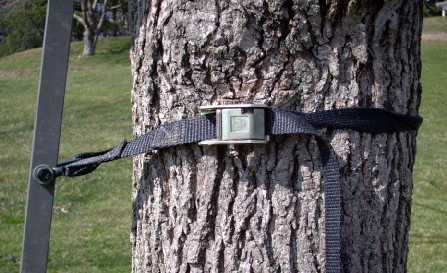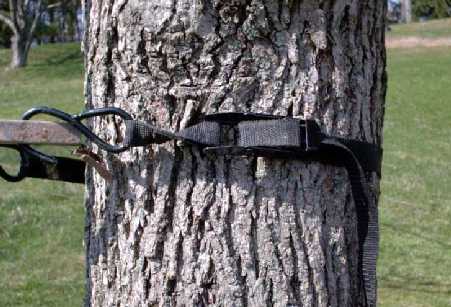|
Tree Steps and
|
When I bought my first fixed position tree stand I needed some way of getting up to the stand as well as getting up the tree to put the stand up in the first place. Screw in tree steps appeared to fit the bill. Since I didn’t know anything about them I bought a couple each of a few different varieties. This let me try them out and gave me the insight that I needed to purchase those that would be the easiest to use.
The tree step that I liked the best was the EZY Climb Step with the fold out screw. The most important quality that I liked about them was the ease of starting the screw into the tree. If you’ve clung onto the side of a tree trying to screw in steps you know how important this is, but if not let me tell you this is very important. The EZY step can be started in with one hand. Also, the fold in screw makes the step smaller and allows you to carry them in your pocket without them poking holes through. The EZY Climb Folding Step that folds twice is also a good step but with two hinged points it is a little harder to start into the tree. All of this, of course, is dependent on the type of tree that you are trying to screw the step into and whether or not your forearms look like Popeye’s.
The best screw in tree step that I have found is the Ezy Climb Deluxe Tree Climbing Step. You can find them at
Climbing Sticks
Climbing sticks are called many different things depending on the manufacturer including: quikstiks, tree ladders, kwik step ladders, portable stick ladders, quik stiks, quick steps, stacking sticks and climbing poles. Basically you have two varieties to choose from, those where each section slides down into the next and those where the sections are strapped onto the tree independent of the other sections. Each type has its pros and cons.
One of the advantages for the climbing sticks whose sections slide into each other includes stability. These sticks are each interconnected so that your weight is transferred to the ground as well as being held by the straps. This gives the climbing stick a sturdy feeling. Climbing sticks also make it easier to set up a tree stand due to the increased stability. The stacking nature also makes them a little easier to install. I put them together completely on the ground and then lean it up against the tree and start climbing and strapping. You always have something to hold onto. On the other hand the increased stiffness of these steps can also be a drawback. They can be somewhat less flexible on irregularly shaped trees, but you can generally make it work.
The sticks that are installed in separate sections also have advantages. Irregularly shaped trees are not a problem as the separate sections can follow the different contours of the tree and may even rotate around a tree. The separate sections also allow for you to vary the height that you can go, within reason. The biggest drawback with this style is probably the increased difficulty in setting them up. The section that you are strapping onto the tree is not connected to anything, thus you are hanging onto the tree while strapping it on, but at least you are standing on a stable section below.
The most important thing in ease of use doesn’t have to do with the ladder style but with the buckle system. My two climbing sticks have two different types of buckles and one is much easier than the other is. I tried to look through the catalogs and determine what the buckle was called that was the best but they all seem to call than cam buckles. The easiest of mine has a buckle that you simply pull the strap through to tighten and to release there is a spring tensioned release that you press to easily allow the strap to loosen. The Gorilla brand climbing stick that I have has this style of cam buckle. A picture of this buckle is shown below.
One additional item of note is the construction of the climbing stick. Like tree stands, climbing sticks made of aluminum are much lighter. This light weight always makes it easier any time you have to carry them through the woods. One climbing stick I have is aluminum and the other is steel and there is a difference although not drastic.
My son is much more comfortable climbing into a tree stand using climbing sticks. This was the original reason that I bought them in the first place and they have paid off. Anyone leery about using single screw in or strap on steps should give a set of climbing sticks a try. Last year I actually used my climbing sticks more than the screw in steps. I was told and thought that they would make tree stand moves more difficult, but I did not find this to be true for me.
I found that the biggest advantage for the screw in steps was that you can put them in your pockets and carry them anywhere, whereas your not as likely to carry the climbing sticks over hill and dale. Each type of step still has its place.
Climbing Sticks
Climbing sticks are called many different things depending on the manufacturer including: quikstiks, tree ladders, kwik step ladders, portable stick ladders, quik stiks, quick steps, stacking sticks and climbing poles. Basically you have two varieties to choose from, those where each section slides down into the next and those where the sections are strapped onto the tree independent of the other sections. Each type has its pros and cons.
One of the advantages for the climbing sticks whose sections slide into each other includes stability. These sticks are each interconnected so that your weight is transferred to the ground as well as being held by the straps. This gives the climbing stick a sturdy feeling. Climbing sticks also make it easier to set up a tree stand due to the increased stability. The stacking nature also makes them a little easier to install. I put them together completely on the ground and then lean it up against the tree and start climbing and strapping. You always have something to hold onto. On the other hand the increased stiffness of these steps can also be a drawback. They can be somewhat less flexible on irregularly shaped trees, but you can generally make it work.
The sticks that are installed in separate sections also have advantages. Irregularly shaped trees are not a problem as the separate sections can follow the different contours of the tree and may even rotate around a tree. The separate sections also allow for you to vary the height that you can go, within reason. The biggest drawback with this style is probably the increased difficulty in setting them up. The section that you are strapping onto the tree is not connected to anything, thus you are hanging onto the tree while strapping it on, but at least you are standing on a stable section below.
The most important thing in ease of use doesn’t have to do with the ladder style but with the buckle system. My two climbing sticks have two different types of buckles and one is much easier than the other is. I tried to look through the catalogs and determine what the buckle was called that was the best but they all seem to call than cam buckles. The easiest of mine has a buckle that you simply pull the strap through to tighten and to release there is a spring tensioned release that you press to easily allow the strap to loosen. The Gorilla brand climbing stick that I have has this style of cam buckle. A picture of this buckle is shown below.
One additional item of note is the construction of the climbing stick. Like tree stands, climbing sticks made of aluminum are much lighter. This light weight always makes it easier any time you have to carry them through the woods. One climbing stick I have is aluminum and the other is steel and there is a difference although not drastic.
My son is much more comfortable climbing into a tree stand using climbing sticks. This was the original reason that I bought them in the first place and they have paid off. Anyone leery about using single screw in or strap on steps should give a set of climbing sticks a try. Last year I actually used my climbing sticks more than the screw in steps. I was told and thought that they would make tree stand moves more difficult, but I did not find this to be true for me.
I found that the biggest advantage for the screw in steps was that you can put them in your pockets and carry them anywhere, whereas your not as likely to carry the climbing sticks over hill and dale. Each type of step still has its place.
Click here to see the review of the tree stands that I climb into using these tree steps and climbing sticks.




Return from Tree Steps and Climbing Sticks to Hunting Supplies.
